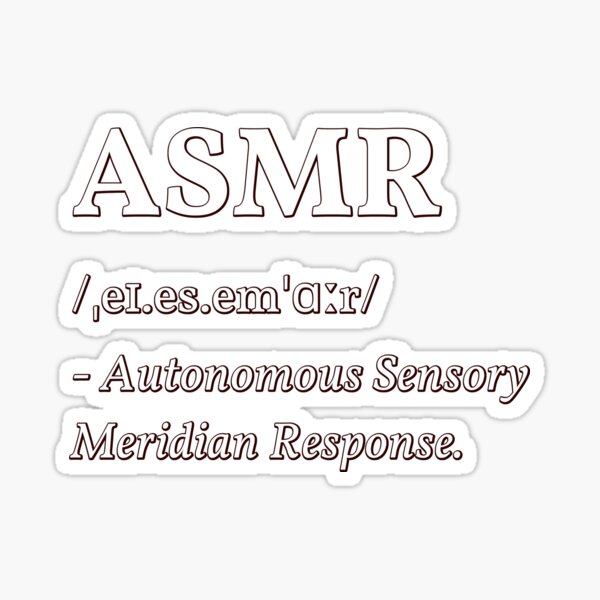ASMR Meaning – What does ‘ASMR’ mean?
ASMR Meaning – What does ‘ASMR’ mean?: ASMR, or Autonomous Sensory Meridian Response, is a physical sensation characterized by a tingling sensation on the skin, often starting at the scalp and moving down the back of the neck and upper spine. This sensation is typically triggered by specific auditory or visual stimuli, such as soft whispers, gentle tapping sounds, or slow, deliberate hand movements.
RELATED: UWU Meaning – What does ‘UWU’ mean?
Table of Contents
While the term ASMR has only been in use for a relatively short period of time, the phenomenon itself has likely existed for much longer. Many people report experiencing the sensation in response to various stimuli throughout their lives, but until recently, there was no widely accepted name or explanation for this experience.
In recent years, however, the ASMR community has grown significantly, with thousands of videos and online communities dedicated to exploring and sharing the various triggers and experiences associated with this phenomenon. Some people find ASMR to be relaxing or even pleasurable, while others simply find it interesting or intriguing.
Despite its growing popularity, however, there is still much that is not known about ASMR. Researchers have only recently begun to study the phenomenon in depth, and there is still much to learn about the underlying mechanisms that cause these physical sensations.
One theory is that ASMR is related to the release of endorphins, which are chemicals in the brain that are associated with feelings of pleasure and relaxation. It is thought that certain stimuli, such as soft sounds or gentle touch, may trigger the release of these chemicals, leading to the physical sensations associated with ASMR.
However, while this theory is promising, there is still much research that needs to be done to confirm it. It is also possible that there are other factors involved in the experience of ASMR, such as individual differences in brain chemistry or sensitivity to certain stimuli.
Despite the lack of a clear scientific explanation for ASMR, many people continue to find it to be a valuable and enjoyable experience. For some, it can be a helpful tool for relaxation or stress relief, while others simply enjoy the unique sensations that it provides.
If you are interested in exploring ASMR for yourself, there are many resources available online. You can find a wide variety of videos and audio recordings that are designed to trigger the sensation, as well as online communities where you can connect with others who share your interest in this fascinating phenomenon.
Overall, ASMR is a unique and intriguing experience that has captured the interest of many people around the world. While much is still unknown about this phenomenon, it is clear that it has the potential to provide a range of benefits and experiences for those who are interested in exploring it further.
Origin of ASMR
ASMR, which stands for Autonomous Sensory Meridian Response, is a term that was first coined in 2010 by Jennifer Allen, who created a Facebook group dedicated to the sensation. However, the sensation itself has been experienced by people for much longer, with reports dating back to at least the early 20th century.
The origins of ASMR are not well understood, and research on the topic is still in its early stages. However, it is thought to be a physiological response to certain stimuli, such as soft sounds or gentle touches, that triggers a pleasant tingling sensation in the body, particularly in the scalp and neck area.
ASMR gained popularity in the early 2010s with the rise of social media, particularly YouTube, where creators began producing videos specifically designed to trigger the ASMR response in viewers. These videos typically feature soft spoken or whispered voices, gentle tapping or scratching sounds, and other similar stimuli.
Today, ASMR has become a widely recognized phenomenon, with millions of people around the world reporting experiencing the sensation. While the scientific understanding of ASMR is still developing, it has become an increasingly popular area of research, with studies exploring its potential benefits for relaxation, stress relief, and sleep.
Uses of ASMR
ASMR has been used for a variety of purposes, including:
1. Relaxation and stress relief: Many people use ASMR to help them relax and unwind after a long day. The sensation is often described as calming and soothing, and can help to reduce feelings of anxiety and stress.
2. Sleep aid: ASMR has been found to be helpful for some people who have difficulty falling asleep or staying asleep. Watching ASMR videos before bed can help to induce a state of relaxation and calm, making it easier to drift off to sleep.
3. Pain management: Some studies have found that ASMR can be effective in reducing the perception of pain. The calming and relaxing effects of ASMR can help to reduce feelings of discomfort and make it easier to manage pain.
4. Meditation and mindfulness: ASMR can be used as a tool for meditation and mindfulness, helping to promote a sense of calm and focus. Some people find that the tingling sensation associated with ASMR can help them to stay present and focused during meditation.
5. Entertainment: ASMR has become a popular form of entertainment, with millions of people tuning in to watch ASMR videos on YouTube and other platforms. Many people find the sensation enjoyable and relaxing, and enjoy watching ASMR videos for entertainment purposes.
Importance of ASMR
The importance of ASMR lies in its potential to provide benefits for various aspects of mental and physical health. It can be a valuable tool for relaxation, stress relief, and sleep aid, which are essential for maintaining good mental and physical health. ASMR may also have potential benefits for pain management and meditation, as well as being an enjoyable form of entertainment.
Furthermore, the popularity of ASMR has led to increased awareness and acceptance of the phenomenon, which has helped to reduce the stigma surrounding it. This has allowed more people to explore and benefit from the sensation, and has encouraged more research into its potential uses and benefits.
Overall, while the scientific understanding of ASMR is still in its early stages, it has the potential to be a valuable tool for promoting mental and physical well-being. Its importance lies in its ability to provide a natural, non-invasive, and enjoyable way to help people relax, reduce stress, and improve their overall quality of life.
Conclusion
ASMR is a sensation that has been experienced by people for many years, but has only recently gained recognition and popularity with the rise of social media. It is a physiological response to certain stimuli that triggers a pleasant tingling sensation in the body, particularly in the scalp and neck area.
ASMR has been used for a variety of purposes, including relaxation, stress relief, sleep aid, pain management, meditation, and entertainment. While the scientific understanding of ASMR is still developing, it has become an increasingly popular area of research, with studies exploring its potential benefits for various applications.













